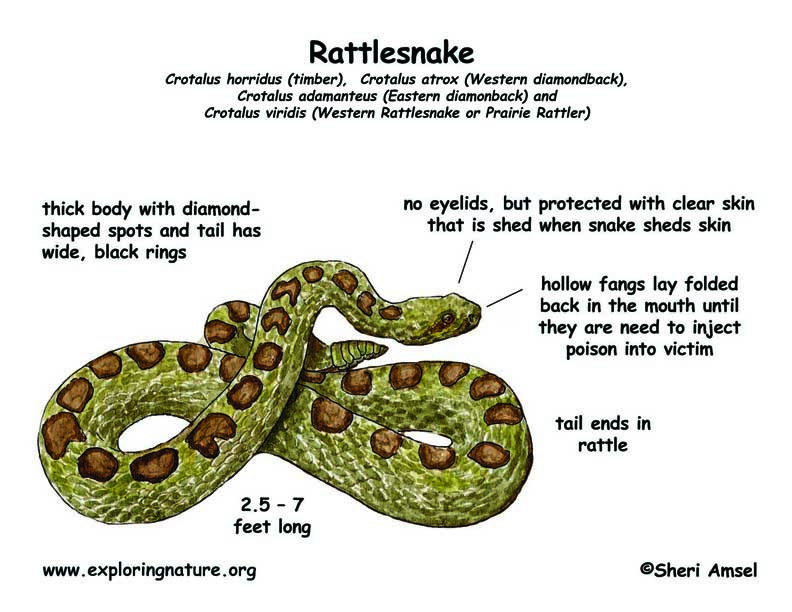

There are 4 kinds (species) of rattlesnake in North America: Crotalus horridus (timber), Crotalus atrox (Western diamondback), Crotalus adamanteus (Eastern diamonback), and Crotalus viridis (Western Rattlesnake or Prairie Rattler).
The Eastern Diamondback is found in North Carolina south through to Florida. The Western Diamondback is found in Arkansas and Texas west to Southern California. The Timber Rattler was once all over the U.S. east of the Rocky Mountains and southeastern Canada, but is now found only in spotty areas throughout its old range. It is thought to be gone from Canada, Maine and Rhode Island and endangered in the rest of its range. The Western Rattlesnake (Prairie Rattler) is found from Iowa westward through the Rocky Mountains and from Southern Canada south to Mexico.
Each type of rattlesnake lives in its own habitat. The Eastern Diamondback lives in forests and scrubby areas. The Western Diamondback lives in many habitats from mountains to lowlands. The Timber Rattler lives in forested areas. The Western Rattlesnake lives in grasslands and rocky areas.
The Eastern Diamondback is 3 to 8 feet long with a thick body and dark diamonds with light centers and a ring of yellow scales around each run down their back. Their tail ends in rattle. The Western Diamondback is 2.5 to 7 feet long with a thick body with diamond-shaped spots. Their tail has wide, black rings and ends in a rattle. The Timber Rattler is 3 to 6 feet long with blotchy marking and a black tail that ends in a rattle. The Western Rattlesnake is 1.5 to 5 feet long with brown blotches down its back. Their tail ends in rattle. Rattlesnakes have no eyelids, but their eyes are protected with a clear skin that is shed when the snake sheds its skin. They have fangs that lay folded back in the mouth until they need to use it. The fangs are hollow and inject poison into their victim.
They “smell” using their tongue, which picks up smells in the air when they flick it in and out. Rattlesnakes are “pit vipers.” This means that they have heat-sensing spots on the sides of their heads that helps them find warm-blooded prey. Rattlesnakes come together in rocky places to hibernate for the winter.
They eat rodents like mice, rats and prairie dogs, amphibians, and small birds.
They are hunted by big birds of prey, like hawks, eagles and owls. They also have been hunted a lot by man.
The female's skin has a scent that tells males when they is ready to mate. She gives birth to 4 to 12 live young who have to feed themselves from birth.
When you research information you must cite the reference. Citing for websites is different from citing from books, magazines and periodicals. The style of citing shown here is from the MLA Style Citations (Modern Language Association).
When citing a WEBSITE the general format is as follows.
Author Last Name, First Name(s). "Title: Subtitle of Part of Web Page, if appropriate." Title: Subtitle: Section of Page if appropriate. Sponsoring/Publishing Agency, If Given. Additional significant descriptive information. Date of Electronic Publication or other Date, such as Last Updated. Day Month Year of access < URL >.
Amsel, Sheri. "Rattlesnakes" Exploring Nature Educational Resource ©2005-2024. December 14, 2024
< http://www.exploringnature.org/db/view/512 >


